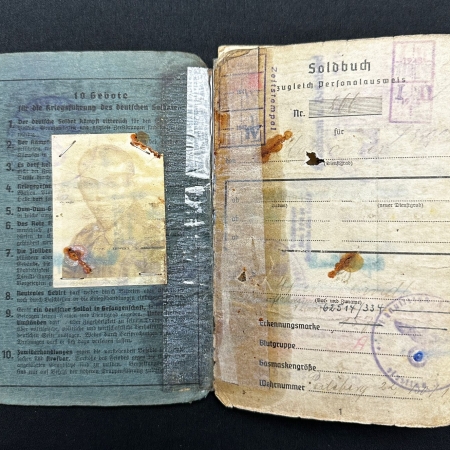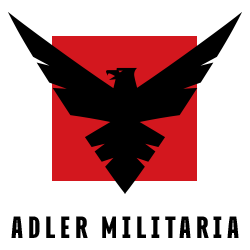Showing 127–135 of 1093 resultsSorted by latest
-

-

WWII German Soldiers Wehrpass Grouping – Wartime Diaries !!! – Obgf Paul Kandl – Heeres Pioneer Batl 268 – Book Project – Rare (Reserved)
This incredible grouping comes with what many never had the time to do, keep meticulous diaries. Pual Kandl served in various units such as Eisenbahn (Train) Sapper Units. He was killed on the 30.6.1944 in Russia. His Feldpost – one letter was returned as he was Killed in Action. Final Comments This is a great book project, German Soldiers were not encouraged to keep such diaries, having his whole war service covered as well as his Wehrpass and KIA Letters, Photos and Feldpost. This makes for a great project these are very hard to find with diaries.
-

WWII US Army Secret Memorandum – Battle of the Bulge – 325 Glider Infantry Ardennes December 1944 – 82nd Airborne – Rare (Offer Accepted)
An interesting report, detailing specifics such as agreed points, enemy activity etc. This is marked clearly secret. Its an original and something for the serious Ardennes Collector. Original Period Item
-

WWII German Lot Of Souvenirs – Bring Backs – OKH Map – Arm Band – Nazi Coins – Letters – Soldbuch Scans 1st Panzer Division – Portrait Wehrmacht – WHW
An odd lot of Third Reich Items bring backs from Europe by a US GI.
-

WWII Original Luftwaffe Confirmed Kills – Vienna 1945 B-24 Bomber – Uffz Paul Becker – Rare Documents
Great set and worthy of further research. Becker scored a kill over Weiner Neustadt, downing a B24 Bomber of the USAF. Such documents are quite sought after.
-

WWII German Original Wehrmacht Bericht 278 Infanterie Division – Italy 1944 – Rare (Offer Accepted)
Nice Original item related to the 278 Inf Div time in Morrovall, Filotteran, Osimo, Casrelfidardo in Italy.
-

WWII US Army Grouping – Nuremberg Trials – US Army Judicial Patch – Holocaust – Documents – Photo – Einsatzgruppen – Rare
Here we have an incredible chance to have an historical grouping. Included are the following items: Original Period Print – Military Tribunal – Number One – Nürnberg Germany 1946 – 1947 Original Period Print. Military Tribunal – Case 9 – nürnberg Germany 1947 – Justice US Patch Original Rare US Army Europe Patch Original Photo of the Tribunal in Session -Note patch in wear – Göring and other Nazi War Criminals Interestingly Case 9 On September 10, 1947, the US Military Government for Germany created Military Tribunal II-A (later renamed Tribunal II). This tribunal was tasked with trying Case #9 of the Subsequent Nuremberg Proceedings: United States v. Otto Ohlendorf, et al.. Case #9 is usually referred to as the Einsatzgruppen View This Term in the Glossary Case. The 24 defendants in Case #9 were all leading members of Einsatzgruppen that operated on the Eastern Front during World War II. The Einsatzgruppen View This Term in the Glossary were special task forces of the SS and Police. The Einsatzgruppen led by the defendants organized and conducted mass shootings of Jews, Communists, and others in territory that Germany seized from the Soviet Union. The Indictment and Charges On July 29, 1947, the 24 defendants in the Einsatzgruppen View This Term in the Glossary Case were indicted for their role in murdering between 723,661 and one million people “as part of a systematic program of genocide.” The indictment listed three charges: crimes against humanity war crimesmembership in organizations declared criminal by the International Military Tribunal Twenty-four Einsatzgruppen View This Term in the Glossary members were charged. Each one was charged with committing all three counts between June 1941 and July 1943 https://encyclopedia.ushmm.org/content/en/article/subsequent-nuremberg-proceedings-case-9-the-einsatzgruppen-case#:~:text=Case%20%239%20is%20usually%20referred,of%20the%20SS%20and%20Police. More the Tribunal
-

WWII Original German Luftwaffe Soldbuch – FJ Albert Berndt – Fallschrim Flakregiment 12 (mot) – 3. Fallschirmjäger-Division – Fallschrim Flak Abt 3 – Normandy & Battle of the Bulge – Rare – Reserved
Berliner Albert Berndt was from Berlin Pankow, born in 1922. Soldbuch was issued 16. Feb 1941. serving with various flak units until his transfer to : Fallschrim Flakregiment 12 (mot) The regiment was formed in January 1944 with three departments (15th batteries) for the II Parachute Corps and deployed in the west. In June 1944 it was renamed Parachute Flak Regiment 12. He was wounded by a bullet in 1942 on the Eastern Front. Western Front Entry – Moved to FJ in 15th of July 1944 as well as a FJ security stamp in June 1944. Fallschrim Flak Abt 3 – 11.44 Heeresgruppe B Kranenburg, Arnhem, Düren, Hürtgenwald 12.44 – 1.45 LVII.AK / AOK.15 Battle of the Bulge (Stadtkull, Manderfeld, Bütgenbach, St. Vith) 2.45 – 3.45 LXXIV.AK / Pz.AOK.5 Manderfeld, Euskirchen, Remagen, Mehlem, Eifel 4.45 XII.SS AK / Pz.AOK.5 Remagen, Ruhr-pocket The 3rd Parachute Division was an airborne division which fought during World War II. It was formed during 1943–44 around a cadre consisting of the veteran 3rd Battalion, 1st Parachute Regiment. The Division was well equipped with 930 MG42s. Each company had 20 MG 42s and 43 sub machine guns while a squad had 2 MG42s and 5 sub machine guns. It arrived in Normandy on 10 June, by truck after a night drive from Brittany. It was at full strength and consisted of young German volunteers, and numbered 15,976 soldiers and officers. Its level of training and excellent weapon systems prompted the commander of the US 29th Infantry Division to remark, “Those Germans are the best damned soldiers I ever saw. They’re smart and they don’t know what ‘fear’ means. They come in and they keep coming until they get their job done or you kill ’em.”[4] The division went into combat in June 1944 in Normandy and inflicted heavy losses on the Allied forces opposing them. Nominally, the unit was to be motorised, but by June it still had no more than 40% of its authorised motor transport, even after seizing vehicles from French civilians. This was to have an impact when trying to move the division towards the invasion front. In August it was near virtually destroyed by mass aerial bombing in the area of Falaise. Formed again in Belgium from replacements from 22nd, 51st, 53rd Luftwaffe Field Regiments. During September 1944 it fought as a part of Kampfgruppe “Becker” in Arnhem area before participating in the Battle of Hürtgen Forest. It surrendered in April 1945 to American troops in Ruhr. Medals Eastern Front Medal Iron Cross Second Class Wounds Badge ( Page likely gone) Flak Specialist Badge Comments The Soldbuch is not in the best condition, but it was there. A highly desirable unit, and he was an experienced Flak Soldier. He was captured by US Troops, woulded by a grenade fragment in the right hand. His Photo was stapled again but its the original photo from the Soldbuch.
-

WWII German Luftwaffe Pilots ID – 1945 Issue – Oberfeldwebel Kurt Stranz – Shot Down September 1939 Survived – Do 17 – Rare Story
9 Sep 1939 3(F)./122 Do 17 F6+BK Lemberg – Missing, crew MIA Oblt Hans-Laurent Amm (B); Uffz Friedrich Schackert (Bf) and Fw Kurt Stranz (F) all captured. It Seems that Stranz was wounded as you can see he has been warded the Iron Cross Second Class and the Black Wounds Badge, alongside his Pilots Badge. A nice ID which is desirbale for anyone interested in hsi unit also at the time of his crash. Aufkl. Gr. 122 Sep 1939 He is also mentioned in the link below: https://luftwaffedata.co.uk/index.php/Aufkl._Gr._122_Sep_1939




